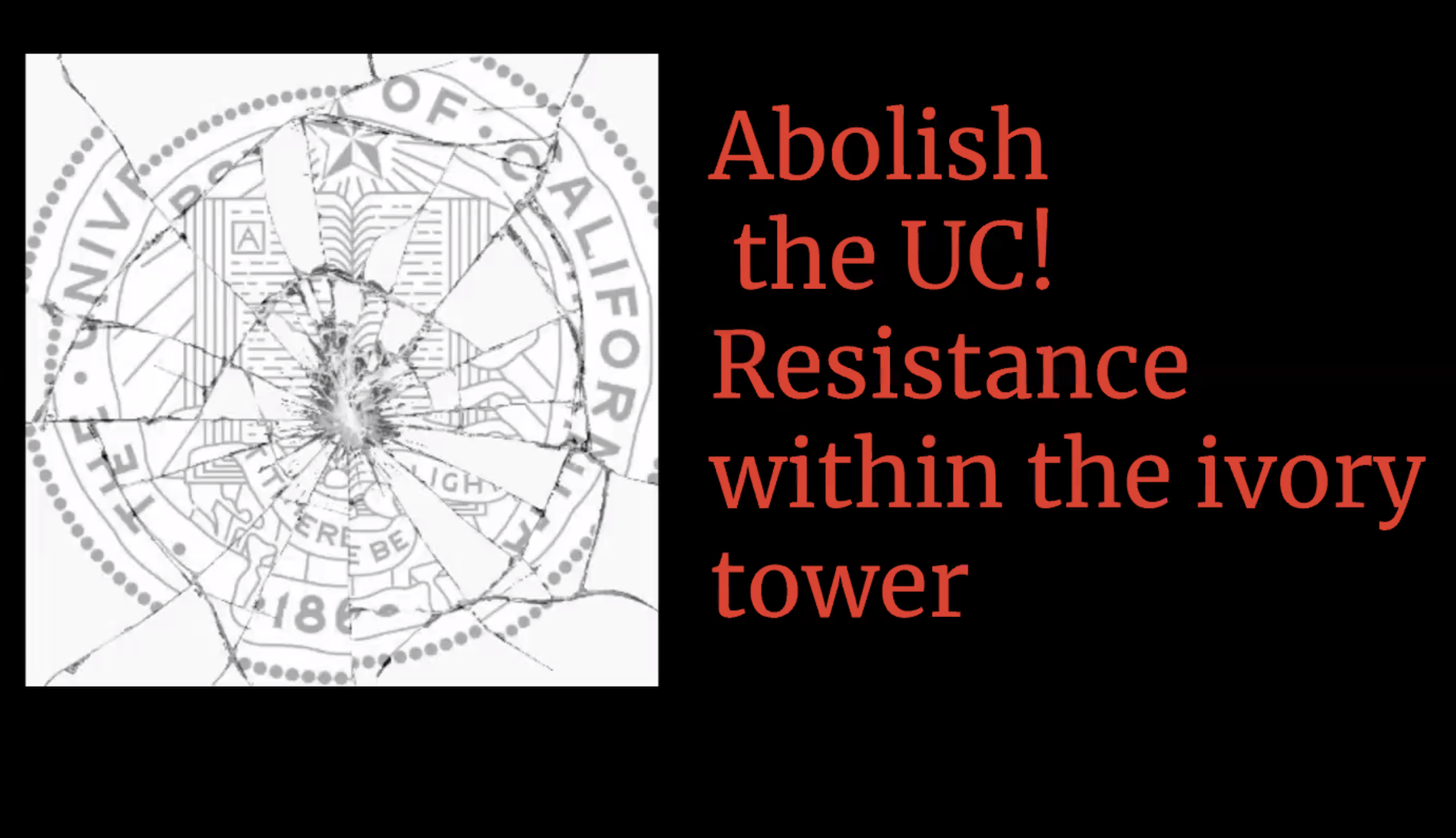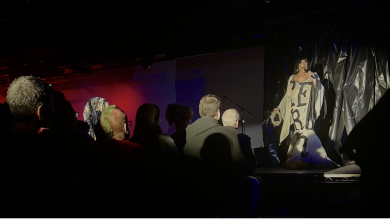Surviving and Thriving Within Academia: An Abolitionist Perspective

Image Description: A screenshot of a black PowerPoint slide with a picture of a shattered University of California emblem on the left. Red text on the right reads, “Abolish the UC! Resistance within the ivory tower.”
In an online event entitled “Demystifying Grad School and Surviving Academia,” graduate students from various University of California (UC) campuses discussed the problematic practices of the UCs through an abolitionist lens. This event was organized and hosted by Abolish the UC, “a formation of BIPOC, queer, and first-generation graduate student workers and [their] accomplices, drawn together by shared visions and antagonisms.” These seven speakers, Ella, Nalya, Diana, Bre, Carlos, Brenda, and Jazmin, discussed how to navigate academia as students from marginalized communities.
The UC system is a settler colonial project; across the state of California, these universities are situated on the stolen lands of the Ohlone, Nisenan, Patwin, Tongva, Chumash, Kumeyaay, Acjachemen, Miwok, Cahuilla, Luiseño, and Serrano people. Brenda also noted how the architecture of UC campuses can be intimidating to Indigenous students in the U.S. Some UC campuses have been known to house mission bells, a deeply painful symbol of destruction, domination, and erasure of Indigenous culture (Catholic missions were sites of physical and sexual violence against Indigenous women in California in the 18th and 19th century, and they have a long history of forcibly converting Indigenous people to Christianity in order to “civilize” them).
Historically, the UC system has demonstrated complicity in genocide, slavery, and the military and prison industrial complexes. The UC system also has a history of harmful investments and affiliations, including several war profiteer companies such as Raytheon and Northrop Grumman. The UCs also recently invested in the Thirty Meter Telescope, a proposed telescope that would be constructed on Mauna Kea, a volcano in Hawaii that is one of the most sacred sites in Native Hawaiian culture. Additionally, the UCs have a known history of research in eugenics: the racist, classist, and ableist practice of attempting to “breed out” traits that are considered undesirable. During the first half of the 20th century, around 20,000 people were forcibly sterilized as a result of this practice in California alone. Needless to say, white supremacy, sexism, ableism, and state-sanctioned violence are foundational to the structures of these increasingly privatized, corporatized, and militarized academic institutions within the UC system.
One message that repeatedly arose throughout the event was that universities will not give marginalized students the resources they need to thrive. Considering the UC’s white supremacist, hyper-capitalistic roots, it’s safe to say that people of color and low-income students are not meant to get ahead in these academic spaces. Ella clarified that the resources are there, but students from marginalized groups face barriers in actually accessing them. This is because such students are oftentimes less familiar with the complicated nature of the UC bureaucracy and generally have less time to figure it out due to non-academic responsibilities like part-time jobs. In contrast, privileged students (that is, white, middle to upper-class students) are more likely to get access to these resources because they are used to asking and getting. In Ella’s words, “privileged students just get to be students.” They don’t have to worry about the racism, sexism, genderphobia, and other forms of discrimination that come along with academia.
The speakers also touched on the hyper-competitive nature of graduate school. In Nalya’s words, getting a B “is considered failing.” According to them, some students will do anything to get ahead, even at the expense of their peers. This toxic culture of constant competition is the result of capitalistic structures; under capitalism, people are conditioned to believe that they need to compete with others in order to succeed. Universities, especially ones that take pride in their low acceptance rates, also encourage competition through the application process both when it comes to undergraduate and graduate admissions. When institutions encourage competition and create unattainably high standards for grades, it’s nearly impossible for students to maintain a healthy relationship with their schoolwork and one another.
Of course, UC schools also create a massive financial burden for students, making it extremely difficult for BIPOC and low-income students to finance their education from UC schools. As the cost-of-living rapidly increases across the U.S., UC universities continue to raise tuition at an unsustainable rate, forcing students into poverty and debt. Although universities claim to support students through financial aid, Jazmin noted that each student receives scholarships and fellowships in different and seemingly arbitrary amounts. Brenda also emphasized that financial aid and funding packages are especially inadequate for student parents. As a mother herself, Brenda shared that she got to the point where she couldn’t even feed her child; although there were food banks on campus, it wasn’t feasible for them to get food from three separate locations throughout the week considering the time constraints that come along with being a student and teaching assistant.
Considering the mental, emotional, and financial burdens that UC schools impose on marginalized students, how can we as a cross-campus community ensure that they thrive? The first step is talking about these inequities. Universities promote a culture of silence and isolation between marginalized students and often “resist knowledge of themselves.” While many UC schools claim to be striving for equity, they fail to provide transparent information about what they are doing to achieve this goal. Even worse, when students express uneasiness with the barriers they face at their universities, they’re gaslighted and ultimately dismissed. In Jazmin’s view, it’s important for students to discuss their financial aid and funding packages to ensure that universities aren’t robbing them any more than they already are and to form a community around this shared sense of uneasiness.
Another important step for students in this process is for them to reframe their mindset in order to continually and actively deny the white supremacist, hyper-capitalistic culture of academia. Surviving within academia isn’t enough — students should be able to thrive. Diana emphasized that within the competitive culture of graduate school, it’s important to prioritize sharing knowledge and supporting other marginalized students. Because universities fail to support marginalized students, it’s important that they build their own networks of support. Nalya also encouraged attendees to focus on learning their “craft” rather than getting a good grade and to push back against the bureaucratic boundaries of knowledge within academia. Ella noted that if students focus on learning their craft, they leave school with skills rather than just a degree, meaning they’re free to write and create in less restrictive settings post-graduation.
The final and potentially most important step that the speakers touched upon was coming together to resist these structures and create support systems for all students. Carlos described how students from all UC campuses have come together to participate in numerous strikes for a Cost-of-Living Adjustment (COLA), proving to be a powerful force — students at UC Santa Cruz were able to shut down their campus entirely on March 5, 2020 and take over a dining hall days later. However, Bre also noted that these conversations should involve more than a cost-of-living adjustment. She saw her area becoming gentrified by white college students and believes that in some ways, the COLA movement could create “better gentrifiers,” which is antithetical to COLA organizers’ goals.
Although the speakers offered advice on how to survive and thrive within academia, they ultimately argued that academic institutions are inseparable from “state violence and capital accumulation,” and the only way to truly solve these problems is to abolish these systems altogether. “Abolish the UC: A Disorientation Guide” emphasizes that the UC system was not constructed to meet the needs or desires of marginalized students. The Abolish the UC movement encourages students to look beyond the confines of modern academia and to imagine what could exist outside these repressive institutions.
If you’re interested in learning more about modern abolitionism, you can read “Abolitionist University Studies: An Invitation” for more information.




